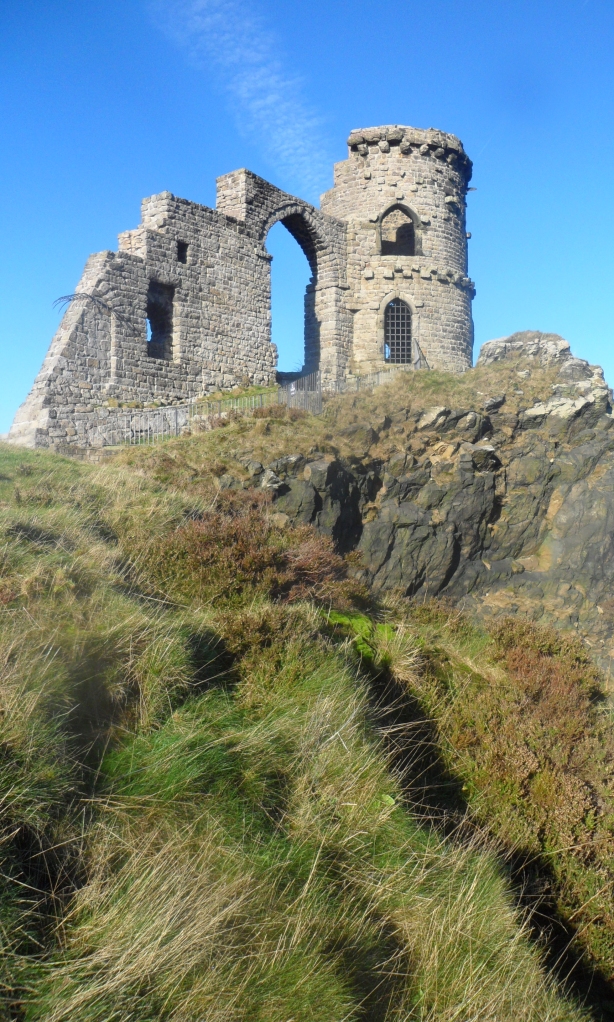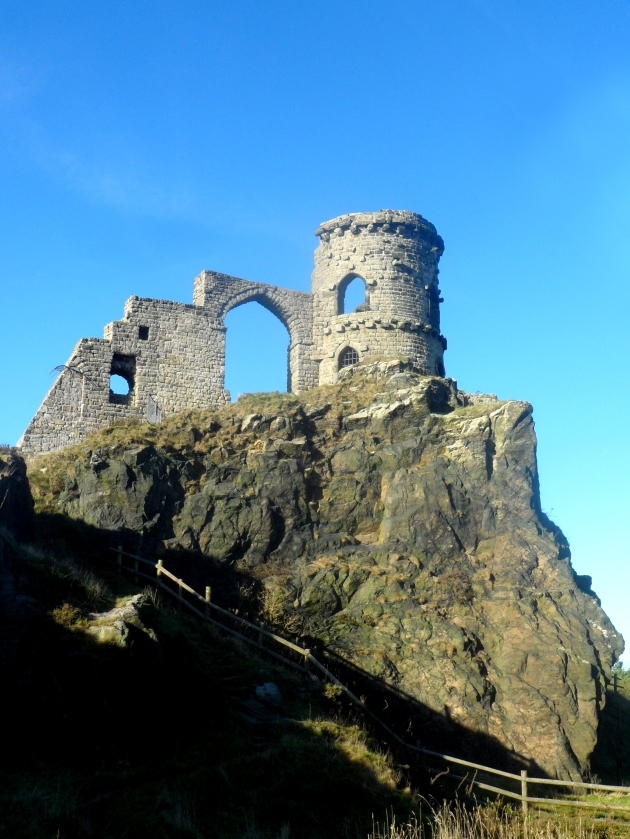Not Cow Mop as I first read it, though I must admit I was quite looking forward to seeing that. With the correct name in the sat-nav (first time I’ve used one) I pointed the car in the direction of the little blue arrow on the screen and tried to ignore the dulcet irish tones instructing me as to how to get off the estate. It is a bright and dry, wintry sunday morning and I’m heading (remains to be seen) for Mow Cop castle in Staffordshire/Cheshire.
The village of Mow Cop is located about 2 miles north-east of Kidsgrove and its elevated position gives it the most expansive views over the Cheshire Plain and beyond.
Forty five minutes later and the Irishman was directing me up a narrowing dirt track with no hope of turning around should I meet anything wanting to come the other way. The track petered out with the phrase ‘you have reached your destination’. Not wanting to appear to be a Luddite to the erudite passenger, I turned off the engine and stepped out of the car. The first thing in view was a narrow footpath leading up to a very craggy outcrop and………the castle. Success I beamed, Cheers Paddy!
The route from where I parked was quite gentle, passing reminders of the quarrying that took place here, long past and now reclaimed by nature again. The stone that was hewn from this site was a very high quality millstone and was ideal for making ‘querns‘ for use in water mills to grind grain. Excavations of the area have uncovered querns dating back to the Iron Age. This practice ended at the end of the Victorian era but the stone was still quarried here until 1937.
After a few hundred yards the path started to wind and climb more steeply and the grass and marsh gave way to jagged outcrops as the path veered sharply left and darted upwards towards the folly.
As follies go, Mow Cop Castle would win no prizes architecturally but what it loses on looks it more than makes up for with the sheer audacity of its location. Standing 1170 ft (356 metres) above sea level the castle is perched atop an outcrop of Yoredale stone and offers uninterrupted views of the plain and land below. The vista once I arrived at the summit was breathtaking with Jodrell Bank looking like a spilt teacup on the green baize below.
This castle is a castle in name only. Built to resemble a ruin it was commissioned by Randle Wilbraham I of Rode Hall, some 3 miles away from the Cheshire side of the hill. Local stonemasons John and Ralph Harding were paid a shilling a day to build it and it is reported that one of the Harding family lost a hand during its construction.
The structure was to be a summer-house for the Wilbraham family to entertain friends on days out and picnics. In the early part of the 19th Century Miss Wilbraham wrote “We have always believed the family tradition, that towards the end of the 18th century, the Wilbrahams, then resident at Rode Hall built the tower. The wall was always broken so as to have the effect of a ruin when looked at from the valley” she also wrote “we were accustomed to boil our kettle and have tea in it on calm days…”
The bigger ‘folly’ factor was to come in the mid 1800’s when Wilbraham’s neighbour Ralph Sneyd, declared that the castle had been built on his land. After a very protracted court case, a judgement was reached whereby it was ruled that the property sat astride both mens property, so both parties were responsible for its upkeep. This unusual ruling still stands today, giving the castle two separate Grade II listings; one for the Staffordshire side and one for the Cheshire side.
In 1923 the Wilbrahams sold their interest to a quarryman, Joe Lovatt. What followed was another bitter legal wrangle that lasted until 1935. This time it was the public who were up in arms. The land and the castle up to this point had been used commonly and they were furious that it had been sold, especially for quarrying.
Mr. Lovatt offered the Castle and a ½ acre of land for public use, if the public would repair the castle. The public refused. The people firmly believed that no one had a right to quarry the land they had used for many years.
Mr. Lovatt carried about his business and many thousand of tons of rock were removed from the quarry. The people meanwhile, backed by their MP formed the Mow Cop preservation committee. In September 1923 a meeting of 500 protesters and 50 committee members marched on the quarry and pulled down loose stone walls, wire fences and even up turned a stone crusher. Time went by, the crowds got less, the committee’s changed and many solicitors’ letters wended their way back and forth.
In the month of June 1937, the quarrying stopped once and for all and the deeds for the Castle and surrounding land were handed over to the National Trust.
On a more ecclesiastical note, the folly is also famous for its association with the Primitive Methodists. In 1807 a Methodist All Day of Prayer was held by Hugh Bourne and William Clowes. As a result of the fervour caused by this meeting, the Methodist Conference (Methodism’s Ruling Body) expelled them both, greatly disapproving of such behaviour. Undeterred, Bourne and his followers formed the Primitive Methodists in 1811, a direct result of the meeting there four years earlier. In celebration of this, over ten thousand Methodists met on the hill in 1937 when the castle and land was handed over to the National Trust, to commemorate the first Primitive Methodist Camp meeting there. That must have been a very crowded hill!
I’d been on the hill for a while now and although the sun was shining, the wind was bitter and the blue hue of my fingers was a good enough indicator that I should make my way back down. After a brief scramble over muddy paths I got back in the car and turned the heater on.
“Right Patrick, where we off?”
“Turn around when possible” said Patrick.
Seemed like a plan.
Description: Mow Cop Castle (That Part in Staffordshire)
Grade: II
Date Listed: 22 April 1988
English Heritage Building ID: 273340
OS Grid Reference: SJ8574957354
OS Grid Coordinates: 385749, 357354
Latitude/Longitude: 53.1132, -2.2143
Location: High Street, Odd Rode, Cheshire East ST7 3NZ
Locality: Kidsgrove
Local Authority: Newcastle-under-Lyme Borough Council
County: Staffordshire
Country: England
Postcode: ST7 3NZ









Nice description of Jodrell Bank as a spilt teacup.